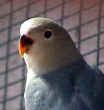|
 |
BREEDS & THEIR NEEDS
LOVEBIRDS
(Agapornis)
Fischers,
Masked, Black-Cheeked & Nyasas +
Peach-faced |
 |
Some of the
info. on this page was submitted by S.P. Club Member, John Gregg,
who is a very knowledgeable Owner and Breeder of Lovebirds
Click on links in Table below
6to
go to specific topics
Nearly all
the photos on this page are "Thumbnails"
- Click on them to see a bigger picture and press the "Back" button to get back
to this page.
|
 |
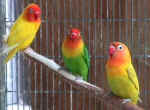 |
 |
 |
 |
|
Blue Fischer |
Lutino - Normal -Dilute Green |
Fischers:
Blue + Normal |
Peach- faced
Agapornis Roseicollis |
Nrml.
Fischer Left
+ Dilute Masked Rt. |
|
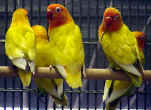 |
 |
 |
 |
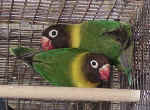 |
|
Lutino Fischers |
Medium Green Fischer |
Normal green Fischer |
Blue masked |
Nrml Green masked |
|
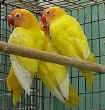 |
 |
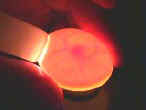 |
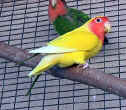 |
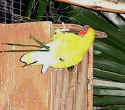 |
Lutino Masked
Lovebirds |
Lovebirds nesting - the
cock is keeping guard but his N.box doesn't have the sentry box. |
Lovebird egg being
"candled" after approx
7 days showing embryo. |
Peach-faced Hen ready to
start laying eggs. You can see the bulge between her foot and her tail in
the picture |
Hen carrying nesting
material on her back under her wings. |
INFO
on the BREED
-
Lovebirds are known as an
"eye-ring species" and originate from Africa.
-
The "Eye Ring" group, as they
are known, are made up of four separate and distinct species of Lovebird
-
The
Masked, Fischer's, the Black-Cheeked
and the Nyasa Love Birds.
-
There are
9 known species of the Lovebird (Agapornis)
-
They are
not sexually dimorphic, so it can be
difficult to know if one has a true pair without the presence of fertile
eggs or without having the birds DNA sexed.

SPECIES PECULIARITIES
-
All Lovebird species can be
colony-bred.
-
In fact, some breeders
believe these birds thrive and breed better in colony settings.
-
Black-cheeked and Nyasa Love
Birds are extremely peaceful in colony setting.
-
The only possible problem is
that Nyasas have been known to attack the youngsters of other pairs that
are emerging from the nest box for the first time.
-
The masked and Fischer's Love
Birds are also peaceful but can occasionally show aggression toward
lone, unpaired birds.
-
While the Masked and
Fischer's are fairly hardy, black cheeks and Nyasas should be wintered
indoors.
-
Prolonged cold and damp
weather can be deadly to them.
-
So a frost-free shelter/shed
is essential
-
+ roof over the Aviary -
perspex or wood.
-
Clear Perspex up the exposed
sides of the Aviary, which can be removed when weather improves.
^Top
MASKED LOVEBIRD
-
They originate from N.E.
Tanzania.
-
Have a look at the photos
above and notice the wide, white ring around the eye.
-
The head should have a solid
black "hood" over it, with yellow around the neck, and a red beak.
-
The flights are black.
-
A Blue Masked will have the
eye ring and black hood, but a blue body with white around the neck,
and a pink beak.
-
Legs : grey
-
A Dilute Masked Lovebird, is
very similar.
-
The differences being that
the Dilute has more white on the head and body and white flights.
-
Masked can be
prone to pluck their youngsters while they are in the nest.
-
Masked are perfectly hardy
and can be wintered outside in a covered Aviary, with dry frost-free
shelter but don't require extra heat.
-
They can stand low
temperatures but damp conditions are
another matter and must be regarded as
a major health hazzard!
FISCHERS LOVEBIRD
-
They
originate from S. Kenya & N. Tanzania
-
They are
hardy, easy to house, feed and breed.
-
An excellent
bird for novices to start with.
-
Mainly
grass-green in colour.
-
Forehead :
bright red
-
Rest of head,
face, neck and breast are an orange-red with a faint olive-green
suffusion.
-
Beak : Red
-
Legs : Grey
-
Sexes look
alike and need DNA test to identify sexes that you are unsure of.
-
Fischers can
be housed as separate pairs or in a colony.
-
They
also are a hardy bird and require similar housing to the Masked
Lovebird. (see above)
-
Young
Lovebirds can be reared without addition to the adults' normal diet.
|
Peach-Faced Lovebird
(Agapornis Roseicollis)
Click to enlarge picture >>
|
 |
|
-
They originate from South &
S.W. Africa
-
Approx. 6"
(15cm)
-
A popular species with Bird
Breeders.
-
Probably the
easiest for Novices to start with.
-
Mainly Apple-green in colour
-
Under surfaces :
Yellow-green
-
Forehead : rose-red
-
Sides of head and throat :
salmon -pink
-
Rump : sky-blue
-
Beak : Yellow
-
Legs : Grey
-
Sexes : alike - DNA to
certify sex.
-
They are "Free Breeders"
but . . .
-
NOT Suitable
for Colony Breeding!
-
They like to roost in their
nest boxes throughout the year inc. Winter and this can lead to eggs
being laid out of season with risk of egg-binding, Dead in Shell (D.I.S.),
+ Chick mortalities.
-
The require similar housing
conditions to the Masked and the Fischers (except at Breeding times,
when they must be housed in pairs).
DIET :
-
They thrive
on Small Parakeet Mix and Millet Sprays.
-
They are very
similar to Cockatiels to feed.
-
Cuttlefish,
Iodine blocks (the pink ones) and grit must be freely accessible at all
times
-
It is esp.
important to make sure they have ALL the above, leading up-to and during
the Breeding season.
-
They
appreciate Egg-food and "Ad Herb" added to the Water when conditioning.
-
Fruit and Veg
is a must to keep them healthy and provide vits and minerals.
-
They love apples,
broccoli, cabbage, kale, carrots, parsley, and spinach.
-
whole grain breads
^Top
SEXING:
-
They are very
difficult to Sex as both sexes look virtually the same.
-
The pelvic
bone can help to tell them apart when in "Breeding condition".
-
The Hens may
appear to have a wider pelvic bone area.
-
This is not
always a 100% way of telling them apart.
-
It has
been said that if you compare the Tail Feathers
-
As in a
lot of other breeds the Heads can, if you study them carefully,
appear slightly different.
-
The Hen's
head is slightly smaller when you see them together
-
The
Cockbird appears to have a more solid, bigger head than the Hen.
-
As I said
after studying my Bourkes - the Stance of most birds can differ
when they are perched RELAXED
-
Either sex
will be alert an upright if they are disturbed or when you first
come into the Aviary but . . .
-
Hens,
when relaxed, often appear to perch in a more horizontal plane to
the perch
-
the
Cockbird sits more erect and higher in it's stance.
-
If you see
a line of birds together it is often more noticeable.
-
You can use
trial and error - i.e. put "pairs" together and wait and see if you get
chicks
-
or let them
pick their own mates, if you breed "en-colony".
-
HENS,
as with most bird breeds tend to BITE and mean it.
-
COCKS
can still bite but not with the same determination as a Hen will.
-
If you get
fertile eggs then obviously they are a true pair.
-
If you get
lots of eggs (i.e. 10-12 per clutch and both birds seem to spend a lot
of time in the Nestbox)
DNA Sexing
is the only sure way.
-
You need to
pull a fresh "blood feather" from the birds' chest
-
or prick the
birds' knuckle and take a tiny drop of blood.
-
Then you send
either (or both) of the above to Avianbiotech or similar to get them
DNA Sexed.
-
It costs
approx £13 per bird (2008)
^Top
TELLING A LOVEBIRDS AGE
-
The best way is to have them
closed ringed as chicks.
-
The second clue as to age is
the first moult.
-
This happens at about 4 - 6
months.
-
Until this happens they have
their immature plumage.
-
The young bird loses its
immature colour as it moults into its adult plumage.
-
The first sign of what is
sometimes affectionately call "measles."
-
Once the "measles" passes
they have their Adult plumage and cannot be aged reliably without a
dated closed ring or DNA testing.
|
Pictures of some young Lovebirds - the 2 on either end are only
a few weeks old.
The 2 in the middle are going through their first moult. |
|
After first moult they start getting little speckles
of colour on their foreheads - see the middle two! |
^Top
PREPARATION for BREEDING:
COLONY BREEDING
-
You put
several pairs in your Aviary (the No. of pairs depends on the size of
your Aviary).
-
Then the
birds pick their own mates and therefore you should end up with true
pairs.
-
Altho. not
necessarily the pairs you may have selected, if you were choosing pairs
to breed in cages.
-
When you put
Nest boxes in you must make sure they are all of similar size and
design.
-
The Nestboxes
are a similar size and design to a budgie nest box but they have a
little "sentry" box
on the end with a perch inside.
-
This is so
that the cockbird can sit in there and guard the nest while the hen sits
it's eggs.
-
The Sentry
box end makes it look like a double nest-box but it has no front to it -
so it's just a
shelter area, with a perch.
-
Hang them all
the same height and the Popholes must also be at the same height and
size - to stop fighting.
-
They all want
the highest one!
-
You must
always put in more boxes than pairs - some people suggest 1/2 as many
again.
-
To help
stimulate the birds into "thinking" breeding you need
to add Willow and Fruit tree twigs and branches.
-
They need a
continuous supply of "sappy" branches as HUMIDITY
in the Nest box is paramount
to the successful incubation conditions of the eggs.
-
When a pair is ready to mate,
they will select a nest box and the hen starts stripping whatever
nesting material is available (newspaper, willow, fruit tree, & hawthorn
branches, palm fronds) with her beak.
-
She will begin tucking them
in her rump feathers, just above her tail, to carry back to the nest.
(see
photo)
-
The birds
then start to strip the bark and use it to build a nest in the nest box.
-
The hen will take these into
her box and arrange them just the way she wants them.
-
She makes a "bowl" in the
back half of the box and a wall of sorts, to separate the front and back
of the box, with a little passage way on the right for going in and out.
-
She will keep going back and
forth until she either is satisfied with the results or runs out of
material.
-
The bird's
protein levels should be upped in preparation for breeding:
-
Egg-food +
Frozen, cooked sweetcorn + Vit and mineral supplement
-
(inc. a calcium
supplement once or twice per week - follow instructions on tub - do not
overdose on calcium as this can do more harm than good).
^Top
CAGE
BREEDING:
-
One
pair to a cage
-
You
can use "selective Breeding" i.e. you decide which bird
goes with which.
-
Make
sure you introduce your pairs gradually because the Hen could
fight and damage the cockbird, esp. if they are not ready to
breed or are not compatible.
-
Poss.
use a breeding cage with a removable mesh slider in between, so
they can see each other and communicate thru the bars.
(similar to introducing canaries).
-
You
need to know the sexes to make sure you have a pair.
-
Optimum cage size: 48" x 24" x 16"
-
With
one Nest box - which they use to roost in when they are not
breeding.
-
This
gives them security and warmth, esp. during the winter months.
-
You
can have the N. boxes on the inside or outside of the cage.
BREEDING INFO:
-
They line their boxes
and make themselves a nest in the Nest box with the willow &
fruit bark stripped off the branches you provided.
-
The Hen makes the
nest.
-
When they have
finished the nest site
-
THEY LAY : 5 - 6 Eggs
every other day.
-
START INCUBATION : after 3rd
Egg is laid
-
INCUBATION : 22 - 23
days (as
they don't start to incubate until 3rd egg - you can make it
easy by adding 5 days to the
incubation period. This is how long it takes from 1st egg being
laid until Egg No.3 being laid.
So if you add 5 onto 22 = 27 days from 1st Egg being laid - this
gives you a more accurate idea.
Then you often get a couple hatching together then another the
following day followed by the
rest at the normal spacing of every 2nd day)
-
HATCHING : The young
hatch on different days, which means they all of diff. sizes.
The chicks are miniscule when they first hatch - no bigger than a 1p piece!! they grow at a fantastic rate, so the parents need a protein-rich diet to enable this to happen.
-
FEATHERS Start to Appear : 10 - 12 days
(so from now u
have some idea of the colours you may have)!
-
FLEDGE: Approx. 35 -40 days and are
fully feathered.
-
RING AT: 8 -
10 days
-
RING SIZE: M
(same size as Kakis)
Just a note : some parents (of all breeds of bird - not just Lovebirds) can object to the "Shiny ring" on their chicks' leg and will try and remove it, often with disastrous results - so if you colour the outside of the ring using a black felt tip pen, prior to fitting, this can help and it will wear off in time.
RINGING : Hold the back 2 feet level with the leg and keep the front 2 together to feed thru the ring and then up the leg past the back to feet.
FOSTERING EGGS AND CHICKS
-
All of the Love bird
species make excellent foster parents for other Love birds.
-
If they are on eggs,
additional eggs can be added, or chicks can even be added to an
existing nest of young.
-
Just make sure that
the eggs or chicks, are within a week of the same age of the
those in the nest that you are adding them to.
-
Also, no more than
five young should be in the total clutch.
-
Infertile pairs can
also be used to foster eggs and raise young.
INTERBREEDING BETWEEN THE 4 SPECIES
(Hybridization)
-
All four species will freely
interbreed with each other, and their off-spring are fertile.
-
It's a tragic mistake to make.
-
It was thought that the "eye-ring
group" was simply one species with four sub-species.
-
This has resulted in massive
hybridization in an effort to produce a variety of colour mutations.
-
This is unfortunate because it
has become increasingly difficult to find 100% pure stock.
-
An example of this
hybridization is found in the "ino" factor (lutino and albino).
-
The only true natural
occurrence of the "ino" factor has been the lutino Nyasa
lovebird.
-
All other mutations,
such as the lutino and albino Masked and Fischer's, and the
lutino Black Cheek, have hybrid blood in them from the Nyasa.
-
Hybridization has
also occurred in the blue series - the blue
Fischer's and blue Nyasa originated from the blue masked.
-
The same holds true
of the dilute mutation (yellow and white) of which the Masked is
the legitimate origin of this color, and the dilute yellow
Fischer's is ultimately of hybrid blood.
FURTHER INFO.
-
They love baths
- so
make sure they have bathing facilities with clean water, daily.
-
They love Willow twiglets, esp. when breeding to make
their nests but also to help provide humidity.
-
They do not mix well
with smaller finches or canaries etc., as they can nip their
legs clean off.
-
Be careful if
adjoining Aviaries contain smaller birds.
-
Make sure they are
double-meshed to prevent such accidents.
-
19g small
1/2" x 1/2" mesh is ideal
and helps prevent vermin getting in too.
-
Lovebirds (Masked &
Fischer) are very hardy and do not need to be kept particularly
warm all the time,
-
They are fairly
consistent in their breeding efforts.
-
With a little luck,
patience and conditioning one can expect about a dozen young
each year from a steady, compatible pair.
-
These birds are fun
to watch - they seem to be little clowns, always showing off.
PARASITES
AVOIDING SPLAY-LEGGED BABIES
Click on this
link and have a read it's quite inspirational :
http://roseicollis.net/Splayed.php
You
know it when you see it:
-
A poor
chick's legs are spread straight out from the body and the chick is
unable to get a grip and sit up with its legs properly underneath its
body.
-
Splay legs
can be very traumatic for the novice breeder.
-
The best
way to deal with this is to PREVENT it.
-
Even the best nest-builders
should be given a basic substrate for the nest box.
-
I recommend
4Easibed
-
Easibed is non-toxic and easy to
get -
-
Put about 2 inches into the
nest box.
-
Then give the hen her usual
nest-building materials.
-
She will build her next on
top of the substrate
-
This prevents the chicks from
ending up on the bottom of a nest box on a slippery wooden floor, where
they can't get a proper grip.
-
It also cushions them if they
have an overzealous mother who sits very tightly on them.
-
If you've already got chicks
in the nest and realize they are hitting the wooden floor, remove
chicks, remove the nest built by the mother (try to keep it basically
intact).
-
Add 2-3 inches of Easibed,
replace mother's nest on top of the substrate, replace chicks
TREATMENT For a chick with splay legs
-
the best way to treat it is to double-band the legs,
-
Use
flat, broad dental floss to tie the legs together (not too
tight) to hold them in the proper
position under the body.
-
Place the baby in a cushioned
cup to help hold it in the proper position.
-
Obviously this can entail
pulling the baby from the nest and hand-feeding it separately from other
chicks,
-
as the string between the legs could strangle other chicks in
the nest.
-
If
you are having difficulty, take the chick to the vet.
-
You do not want to let this
go, as these birds are often severely crippled and will need special
caging and extra help
all their lives.
VERMIN
-
See the note
on
weasels - I
hadn't realised that they can squeeze thru a gap as
small as a man's
wedding band - Just think about it!!!
-
So just
imagine how small a space mice can get through! - I've
seen a mouse go straight thru
a 1" x 1/2" mesh - unbelievable how they do it but they
do!!
-
Mice leave a trail of urine
as they move, which creates instant contamination and
risk of disease to
your birds, esp. if they go into your birds feed dishes.
-
Check this
website out for ultrasonic Pest controls to help keep
vermin out of your Aviaries:
-
www.dazer.com
-
One other
method of keeping mice and other vermin out is to fix
your mesh on top of 2 -3 rounds of breeze blocks,
to give a solid bottom to your Aviary, which isn't so
easy for vermin to negotiate, as they can't get a decent
claw-hold!
-
or if your
mesh goes to ground-level then cover the bottom 18" -
2ft of the mesh with something slippery like big 6
corrugated roof sheeting or a slippery piece of perspex
sheeting.
-
Then the
vermin won't be able to climb up to the mesh height and
gain access to the Aviary.
-
Poison is a
big "no - no" if you have other animals + wild birds,
unless you can put it into a narrow pipe/tube that is
too small for any other domestic animal
-
Make sure you
position it when wild birds can't gain access either.
MOUSE TRAPS :
-
Make a small wooden boxes with lockable lids - approx
6" long by 4" wide and 4" high with
a piece of 1" x 1" mesh across the front - so the mice
can gain easy access
-
Remember,
I said they can get thru smaller mesh than that, so
1" square is easy for them.
-
You then
put a dish of poison inside the box and keep it
replenished.
-
This is
then safe from all other animals and birds, so long
as you keep the lid shut tight.
-
Traps work -
once again beware of other animals and birds.
-
Sweep up and
keep spilt feed cleared up, to deter the vermin.
-
Dispose of
the bodies safely.
Roseicollis.net
A Website dedicated to Keeping and Breeding
Lovebirds
http://roseicollis.net/nature.php
|




















